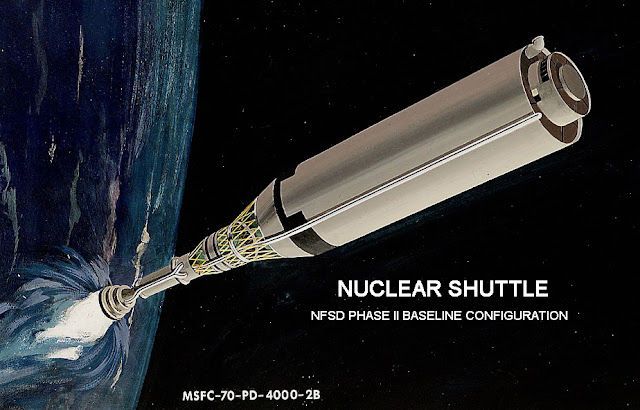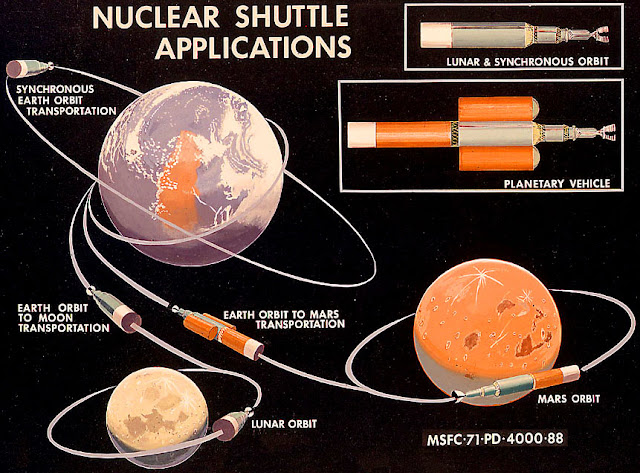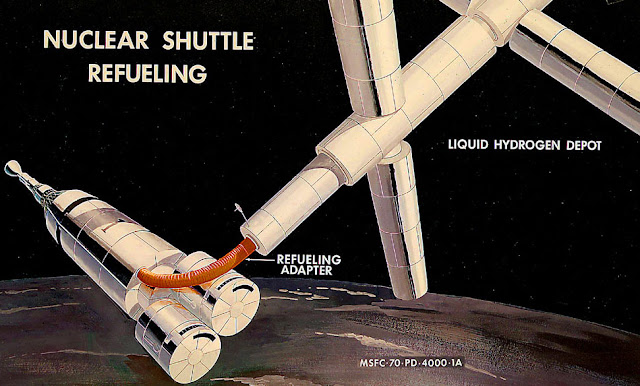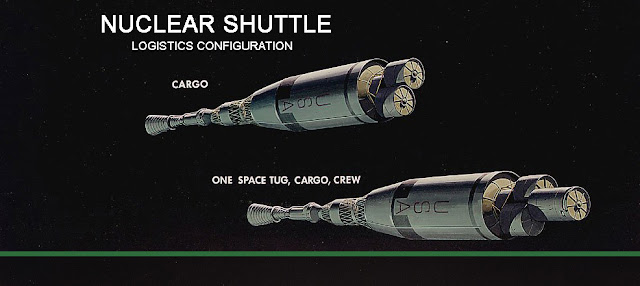The Last Days of the Nuclear Shuttle (1971) |
| Image credit: NASA |
In July 1969, as the Apollo 11 moon landing brought the Apollo Program to its culmination, Lockheed Missiles and Space Company (LMSC), McDonnell Douglas Astronautics Company (MDAC), and North American Rockwell (NAR) began the Nuclear Flight Systems Definition (NFSD) study on contract to NASA’s Marshall Space Flight Center (MSFC) in Huntsville, Alabama. The NFSD study occurred against a backdrop of great change in the U.S. civilian space program, and its evolution through three phases reflected this.
 |
| Cutaway of a typical NERVA nuclear-thermal rocket engine. The explanation of its operation that follows is simplified. Turbopumps push liquid hydrogen propellant from a large insulated propellant tank (not shown) through the reactor core. A reflector focuses neutrons radiated from uranium fuel rods back into the core, causing nuclear fission to occur. Liquid hydrogen picks up heat generated by the fission reaction in the core, helping to prevent the fuel rods from melting. The hot hydrogen then expands outward from the nozzle skirt extension, producing thrust. Liquid hydrogen also cools the nozzle. During engine shutdown, a control drum blocks the reflector, damping nuclear fission in the core. Propellant flow is maintained for a "cool-down" period after fission is halted to prevent fuel rods melting. Note the external and internal radiation shields which reduce crew radiation exposure. Image credit: NASA |
In Phase I of the NFSD study, MSFC charged LMSC, MDAC, and NAR with producing a "detailed analysis [and] conceptual design" of an expendable nuclear-thermal rocket stage equipped with a 200,000-pound-thrust NERVA II engine. The NERVA II was expected to be flight-ready in late 1977. The contractors were directed to study "development requirements of a nuclear propulsion system, including its evolution from a flight test stage to an operational. . .stage."
The Phase I nuclear stage was envisioned as a NERVA II with a single 33-foot-diameter propellant tank sized for launch from Earth atop a two-stage, 33-foot-diameter Saturn V rocket. Its main purpose would be to push piloted spacecraft out of low-Earth orbit (LEO) toward Mars.
Phase II commenced in October 1969, immediately after President Richard Nixon's Space Task Group (STG) endorsed (with reservations) NASA's aggressive Integrated Program Plan (IPP) for future U.S. spaceflight. The IPP was the brainchild of George Mueller's NASA Headquarters Office of Manned Space Flight, which supervised NASA's manned spaceflight centers, including MSFC.
In NFSD Phase II, MSFC directed its contractors to design a reusable nuclear rocket stage equipped with a 75,000-pound-thrust NERVA I engine. The stage, dubbed the Reusable Nuclear Shuttle (RNS), was intended mainly for roundtrip crew and cargo flights between space stations in LEO and lunar orbit. In January 1970, MSFC presented the contractors with an ambitious RNS traffic model calling for 157 Earth-moon flights between 1980 and 1990 by a fleet of 15 RNS vehicles, each toting 50 tons of cargo. Piloted Mars missions, though still considered a part of the IPP, were in NFSD Phase II relegated to secondary importance.
 |
| Image credit: NASA |
As in Phase I, the Phase II nuclear stage would reach Earth orbit on top of a Saturn V rocket. Its liquid hydrogen propellant would, on the other hand, climb into orbit in the payload bay of the proposed reusable winged Earth-to-Orbit Shuttle (EOS). NASA envisioned that more than 40% of EOS flights would be devoted to delivery of propellants. The EOS would pump liquid hydrogen/liquid oxygen propellants it carried directly into the tanks of chemical-propulsion Space Tugs. Most propellant carried in the EOS would, however, be liquid hydrogen meant for RNS propulsion. MSFC engineers envisioned that the EOS would cache RNS liquid hydrogen in LEO at an Orbital Propulsion Depot.
 |
| Electricity from twin nuclear reactors arranged in a "Y" configuration (right) powers refrigeration systems that keep liquid hydrogen stored in the Orbital Propellant Depot from turning to gas and escaping. Image credit: NASA |
 |
| A Reusable Nuclear Shuttle tanks up at the Orbital Propellant Depot using a soft-docking Refueling Adapter. Image credit: NASA |
That same month, NASA Administrator Thomas Paine permanently terminated Saturn V production and canceled Apollo 20 so that its Saturn V could launch the Apollo Applications Program (AAP) Dry Workshop (DWS). In February 1970, NASA gave the AAP DWS the new name Skylab and redesignated AAP as the Skylab Program.
Soon after, MSFC directed LMSC to examine launching the RNS inside the Space Shuttle payload bay, which was expected to measure 15 feet wide by 60 feet long. LMSC's Shuttle-launched "modular" RNS would comprise a NERVA I engine and multiple hydrogen tanks launched separately into LEO and joined together through a labyrinth of pipes. NAR continued work on a single-tank RNS sized for launch on a future heavy-lift rocket, while MDAC divided its study efforts between the two launch options.
Phase II segued into Phase III in May 1970, when MSFC directed the NFSD contractors to assume a 1978 or 1979 NERVA I flight readiness date. The postponement reflected an anticipated Fiscal Year 1971 NERVA funding cut. MSFC also directed the contractors to limit to 150 tons the amount of liquid hydrogen propellant each RNS would carry.
In February 1971, with the NFSD study set to conclude in less than two months, D. J. Osias, an analyst with NASA Headquarters planning contractor Bellcomm, summarized and critiqued reports prepared by the three contractors. He began by examining the ways that the contractors had approached the problem of radiation shielding. "Nuclear propulsion," he wrote, "complicates in-space operations by introducing a radioactive environment."
All the RNS designs included a 3000-pound radiation shield on top of the NERVA I to create a conical radiation "shadow" for crew protection, but also relied on the vehicle's propellants and structure for supplemental shielding. Osias asserted that "in regard to radiation shielding. . .the most optimistic results are being accepted and attention to the problem is diminishing."
He also noted that, as liquid hydrogen was expended as propellant, it would cease to be available to serve as radiation shielding. As the RNS tank or tanks emptied, crew radiation dose would thus steadily increase. To solve this problem, NAR had developed a "stand-pipe" single-tank RNS concept, in which a cylindrical "central column" running the length of the main tank stood between the crew and the NERVA I engine. The central column would remain filled with hydrogen until the surrounding main tank was emptied. MDAC, for its part, had developed a "hybrid" RNS shielding design that included a small hydrogen tank between the bottom of the main tank and the top of the NERVA I engine.
 |
| Image credit: NASA |
 |
| The proper way to load cargo onto a Nuclear Shuttle: I - Use Space Tug robot arms to remove cargo module from Space Shuttle payload bay; II - stack cargo module on Space Tug; III - ignite Space Tug chemical rocket motors to rendezvous with Nuclear Shuttle, taking care to approach within the conical shadow created by the NERVA engine's radiation shields; IV - transfer cargo to Nuclear Shuttle. Image credit: NASA |
 |
| Crew transfer from the Earth-to-Orbit Shuttle to the Nuclear Shuttle might take place at the Orbital Propellant Depot. In this image, the crew of the Earth-to-Orbit Shuttle takes care to remain within the shadow of the NERVA engine's radiation shields. Image credit: NASA |
Osias postulated a maximum allowable radiation dose for an astronaut from sources other than cosmic rays of between 10 and 25 Roentgen Equivalent Man (REM) per year. Astronauts riding an RNS would, however, receive 10 REM each time its NERVA I engine operated. An astronaut 10 miles behind or to the side of an RNS operating at full power would receive a radiation dose of between 25 and 30 REM per hour. Osias noted that the NFSD contractors had recommended that no piloted spacecraft approach to within 100 miles of an operating NERVA I engine.
Radiation would create other operational problems, Osias wrote. Spacecraft could dock with an RNS by approaching through the cone-shaped radiation shadow that protected its crew. Docking an RNS to a large vehicle that protruded beyond the shadow - for example, a space station or a liquid hydrogen propellant depot - would, however, generate obvious problems. The large vehicle's crew might be exposed to radiation from the NERVA I; more insidious, the large vehicle's structure would reflect radiation back at the RNS, endangering its crew.
The NERVA I engine would emit radiation not only while it was in operation; it would also generate spent nuclear fuel that would emit harmful levels of radiation for decades or centuries. Osias noted that NAR had "repeatedly emphasized [that] maintainability is essential to economic operation of the RNS." A spacewalking repairman who approached to within 400 feet of the side of an RNS 10 days after its tenth (and, going by MSFC's traffic model, final) Earth-moon round-trip would, however, receive one REM per hour from the spent fuel it contained. Maintenance robots might replace the servicing capabilities of astronauts, Osias noted, but such systems would need costly development before they could become available.
Osias also reported that the "NFSD contractors. . .devoted little effort to [studying] emergency operations and malfunctions," adding that "[n]uclear systems, more than chemical propulsion vehicles, have the ability to involve the general population of the [E]arth in a space accident." A NERVA I explosion in LEO, for example, could lead to "random reentry of large pieces of radioactive material" that would probably survive reentry heating and strike Earth's surface. He urged that prevention of "return of the NERVA engine to the [E]arth's surface. . .be a basic rule of nuclear propulsion planning."
In NFSD study Phase II, LMSC estimated that, after just one Earth-moon round-trip, enough spent fuel would have accumulated within a NERVA I engine that it would need to remain in a safe high-altitude disposal orbit for 135 years. By the end of its operational life - after ten Earth-moon flights - the "most desirable method of disposing of an engine" would, Osias wrote, be to "send the RNS on an unmanned, one-way mission to deep space."
The same month Osias completed his critique of the PFSD contractor studies, veteran New Mexico Senator Clinton Anderson, a close friend of former President Lyndon B. Johnson and a long-time nuclear rocket supporter, called a hearing to highlight the Nixon Administration's plan to slash NERVA funding from $110 million in Fiscal Year 1972 to only $30 million. At the hearing, Acting NASA Administrator Robert Seamans, an STG member, explained that Space Shuttle development had priority over NERVA development because the Space Shuttle was the essential transportation element that would launch into space all other IPP elements, including the RNS. He told Anderson that "NERVA needs the Shuttle, but the Shuttle does not need NERVA."
Six months after the NFSD contractors completed their reports, the Nixon White House unveiled its Fiscal Year 1973 budget request. As many had feared, it contained no funding for continued NERVA development. Anderson was ill and no longer able to adequately defend NERVA. A group of more than 30 pro-NERVA congressmen sought to sway the Nixon Administration, but to no effect. The final NERVA ground tests occurred in June and July 1972, after which the program was terminated, ending nearly 20 years of U.S. nuclear propulsion development.
Sources"Status of Nuclear Flight System Definition Studies – Case 237," B71 02018 (NASA Contractor Report 116601), D. J. Osias, Bellcomm, Inc., 9 February 1971
Humans to Mars: Fifty Years of Mission Planning, 1950-2000, Monographs in Aerospace History #21, NASA SP-2001-4521, David S. F. Portree, NASA, February 2001
More InformationThink Big: A 1970 Flight Schedule for NASA's 1969 Integrated Program PlanSeries Development: A 1969 Plan to Merge Shuttle and Saturn V to Spread Out Space Program CostApollo's End: NASA Cancels Apollo 15 & Apollo 19 to Save Station/Shuttle (1969)Humans on Mars in 1995! (1980-1981)Source:
The Last Days of the Nuclear Shuttle (1971)